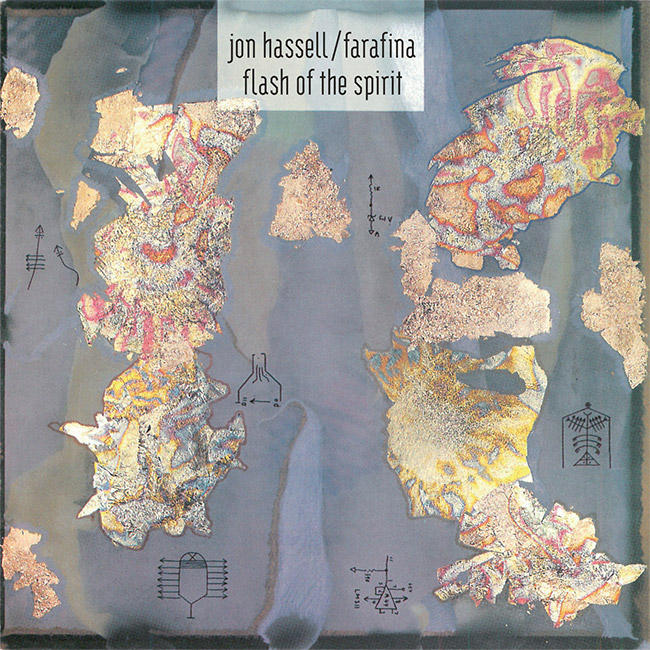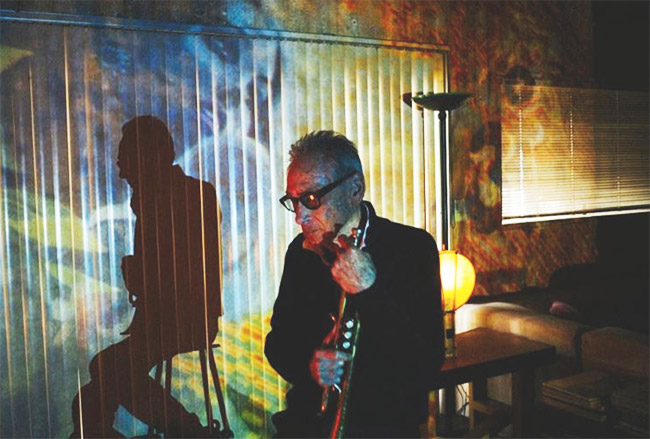
Flash of the Spirit, Jon Hassell, w/Farafina (Tak: Til 2020 [1988])
What has been happening to music? In the world of ambience and sustained tonality, a revisiting of the capabilities of many instruments and combinations has been well underway since the late ‘70s. Music technology has affected much; keyboards have far greater capability now digital, and conventional instruments can undergo digital ‘treatment’. Styles and modalities of music have evolved conspicuously.
One might not think of brass instrumentation as the first place to look for musical innovation and indeed it wasn’t. For the saxophone and trumpet something of a leap can perhaps be grasped, from Miles Davis’ progressive jazz on Bitches’ Brew to for instance the radical ambient soundscaping of a David Bowie on ‘Neukoln’ from ‘Heroes’. Ornette Coleman, who liberated Free Jazz played saxophone and trumpet. But if Miles stretched capability on the trumpet and Coltrane on the sax, the progressive strain might have seemed to have just about peaked by the early ‘70s, Brew from 1970 and the irreplaceable Coltrane gone in 1967. Miles embarked on a six year ‘retirement’ to resurface with the more traditional Man with the Horn in 1981.
It is doubtless a point for argument, but conceivably the most essential presence on the trumpet since Miles Davis, certainly for innovative developments, has been Jon Hassell, who was born in 1937 in Memphis. Hassell’s early progress is actually quite revealing for grasping his style. It would not be inappropriate to suggest that he aimed for a kind of sustained ambience rather than the sometimes freewheeling virtuosity we might find from Miles.
Recounting this development, briefly, can help to clue in where the music is coming from. Hassell has been fortunate, perhaps, in the mentoring process. I’d suggest that at least two developments were consequential in developing his inimitable musical presence. Hassell after his degree in music had gone to Cologne to study with Stockhausen, and returned to the US in 1967. At this time he became acquainted with the seminal minimalist Terry Riley, and indeed performed on the first recording of his path breaking In C. Were this not enough, he also picked up on key avant gardist LaMonte Young and performed at his Theatre of Eternal Music in New York. Now, further to this, Hassell subsequently accompanied Riley and Young in a trip to India, where they encountered the musician Pandit Pran Nath noted for the traditional Kiranic singing style. This made a considerable impact on how Hassell wanted to play the trumpet.
This early nexus may have been the most significant for Hassell. However he also managed to contact the leading ambient musician and producer Brian Eno, with whom he recorded Fourth World: Possible Musics in 1980. The idea of ‘fourth world’ is evidently Hassell’s, ie he wanted ‘a unified primitive/futuristic sound’, so that traditional sources could be incorporated but also electronic enhancements and contributions to the achieved sound.
Hassell undertook quite a number of collaborations. And it is perhaps not surprising that these are more numerous than his solo works. These include Talking Heads, Peter Gabriel at the first WOMAD, Ani DiFranco and many others. The present 1988 reissue was a collaboration with the West African troupe Farafina, and in that sense there are considerable qualities to the music, both in background and foregrounding that are unique to this recording.
I might suggest though that to get a flavour of Hassell’s distinctive trumpet style, which was inimitable and consistent, a very indicative track is the early ‘Caracas Night’ from Vernal Equinox , his first solo album in 1977. The tone I might refer to as a thin or understated sandy and wispy rasp. Hassell seems to have been interested less in virtuosities than in inhabiting and filling out a quality of musical ambience. Tracks like ‘Chemistry’ and ‘Delta Rain Dream’ from the Eno co-production show a more filled out kind of sound, albeit that this presentation’s percussive and keyboard affectations are understated. Meanwhile it is worth noting that David Toop included Hassell’s ‘Empire III’ track on his essential Ocean of Sound compilation in 1996, which manages to gather together many of the extant ambient developments from their noted contributors.
The present album is a rerelease from 1988 which is a collaboration with Farafina. To get a sense of what this ensemble sounds like otherwise, one could consult their CD Bolomakote (1989). Hassell in many ways seems to both centre and blend in for this co-effort.
The ten tracks all come with very evocative titles of a Fourth World kind, from ‘Flash of the Spirit (Laughter)’ to begin, which is appropriately upbeat and ‘Masque (Strength)’ for the long finale. Farafina contribute wind, percussive and keyboard elements.
I have to admit though that I think the positive vibes overall prevail here. There are tracks to evoke and represent fear (‘Night Moves’), which sounds resilient and eventually unalarmed, and prayer (‘Out Pours Blue’), but few dark spirits here. ‘Masque’ is sturdy and self-assertive, with a touch of ready percussive combativeness. ‘Out Pours Blue’ is perhaps rather more meditative, and does manage to flow persuasively and absorbingly in a minimalist kind of way. This is perhaps the most persuasive track here, for me at least, notes of very fluent and aware movement, taking in and appreciating the moving on.
The percussion on ‘Dreamworld (Dance)’ can be a bit sharp, insistently strikey. ‘Air Afrique (Wind)’ has again a rather lifting fluency, with high wind inflections and subtle chorus vocals aiming high to the air stream. The tempo builds just enough to reach a lean and assured finish. 
The trumpet is well in evidence again for ‘Tales of the Near Future (Clairvoyance)’. This starts a little haltingly. Trumpet notes out are almost seeking call back. The trumpet tone can waver in its end phrases. The mood is listening and expectant, antennae on.
Overall, this is something of a unique collaboration. Hassell and Farafina elements get to share the sonic space, again Hassell not one for flamboyance or theatrics. It is illuminating to compare this with the Eno Possible Worlds album, and in a sense this effort manages to look beyond it, that is that Hassell is striving to integrate elements of the traditional and the progressive or futurist. The resulting soundscapes reach out a little further, but are surprisingly centred if not calm, gathering inward strength, the effect pretty robust and differentiated. With Hassell releasing a new album just recently Listening to Pictures (2018) this would seem to be quite the time to revisit the back catalogue, of which this is one of the highlights.
.
Clark Allison
